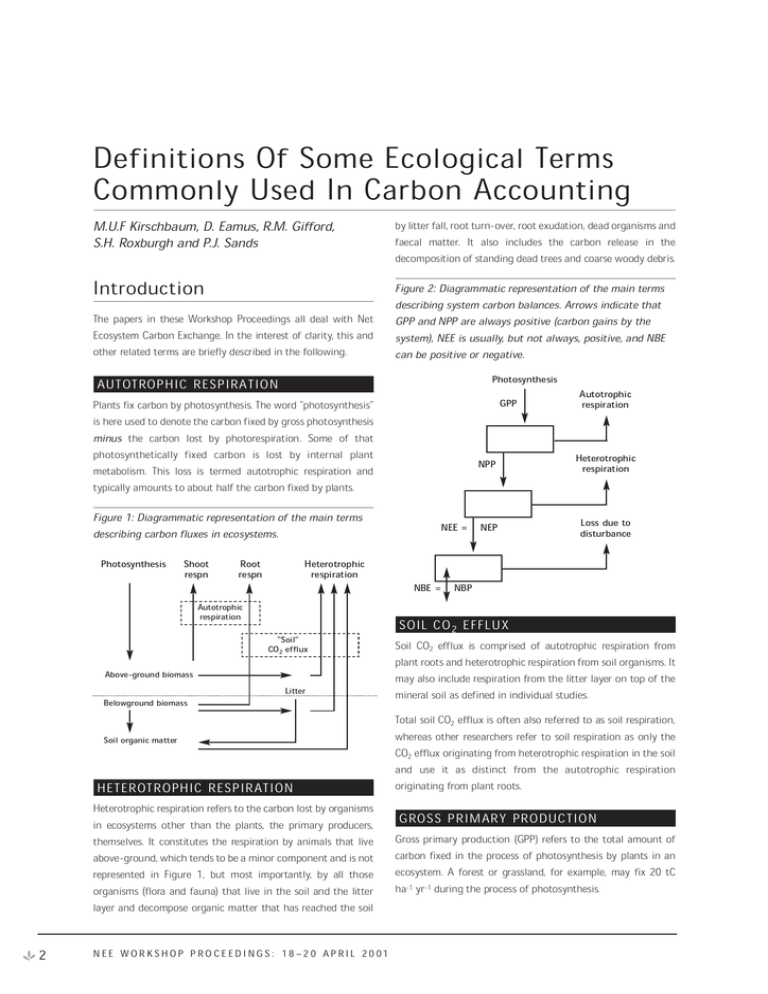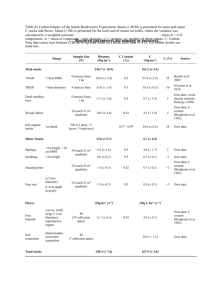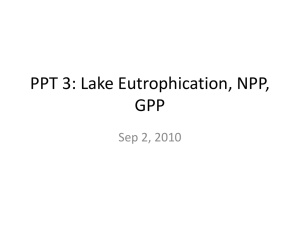C Accounting Definitions
advertisement

Definitions Of Some Ecological Terms Commonly Used In Carbon Accounting M.U.F Kirschbaum, D. Eamus, R.M. Gifford, S.H. Roxburgh and P.J. Sands Introduction The papers in these Workshop Proceedings all deal with Net Ecosystem Carbon Exchange. In the interest of clarity, this and other related terms are briefly described in the following. by litter fall, root turn-over, root exudation, dead organisms and faecal matter. It also includes the carbon release in the decomposition of standing dead trees and coarse woody debris. Figure 2: Diagrammatic representation of the main terms describing system carbon balances. Arrows indicate that GPP and NPP are always positive (carbon gains by the system), NEE is usually, but not always, positive, and NBE can be positive or negative. Photosynthesis AUTOTROPHIC RESPIRATION GPP Plants fix carbon by photosynthesis. The word “photosynthesis” is here used to denote the carbon fixed by gross photosynthesis minus the carbon lost by photorespiration. Some of that photosynthetically fixed carbon is lost by internal plant metabolism. This loss is termed autotrophic respiration and typically amounts to about half the carbon fixed by plants. Figure 1: Diagrammatic representation of the main terms describing carbon fluxes in ecosystems. Photosynthesis Shoot respn Heterotrophic respiration Root respn Autotrophic respiration “Soil” CO2 efflux Above-ground biomass Belowground biomass Litter Soil organic matter HETEROTROPHIC RESPIRATION Heterotrophic respiration refers to the carbon lost by organisms in ecosystems other than the plants, the primary producers, themselves. It constitutes the respiration by animals that live above-ground, which tends to be a minor component and is not represented in Figure 1, but most importantly, by all those organisms (flora and fauna) that live in the soil and the litter layer and decompose organic matter that has reached the soil 2 NEE WORKSHOP PROCEEDINGS: 18–20 APRIL 2001 NPP NEE = NEP Autotrophic respiration Heterotrophic respiration Loss due to disturbance NBE = NBP SOIL CO 2 EFFLUX Soil CO2 efflux is comprised of autotrophic respiration from plant roots and heterotrophic respiration from soil organisms. It may also include respiration from the litter layer on top of the mineral soil as defined in individual studies. Total soil CO2 efflux is often also referred to as soil respiration, whereas other researchers refer to soil respiration as only the CO2 efflux originating from heterotrophic respiration in the soil and use it as distinct from the autotrophic respiration originating from plant roots. GROSS PRIMARY PRODUCTION Gross primary production (GPP) refers to the total amount of carbon fixed in the process of photosynthesis by plants in an ecosystem. A forest or grassland, for example, may fix 20 tC ha-1 yr-1 during the process of photosynthesis. Total global GPP is estimated to be about 120 GtC yr-1 (Gifford 1982; Bolin et al. 2000), and total Australian GPP can be estimated to be 2-6 GtC yr-1 if one assumes that GPP is 2 times NPP and uses the estimates of NPP compiled below. often used to refer to the same processes if measurements are based on ecosystem-carbon stock changes, typically measured over a minimal period of one year. However, these differences in usage are not firmly embedded in formal definitions. NET PRIMARY PRODUCTION In the example of a typical forest, of the total NPP of 10 tC ha-1 yr-1, 5 tC ha-1 yr-1 might be lost in annual turn-over of foliage, fine roots, reproductive structures and other constituents with short longevity, and a similar amount might accumulate in growing stems. When the standing stock of carbon in the litter pool is not changing over time, the input of dead litter must be balanced by an equivalent carbon loss from decomposing litter. The forest’s NEE would then be 5 tC ha-1 yr-1. Net primary production (NPP) refers to the net production of organic carbon by plants in an ecosystem usually measured over a period of a year or more. It is GPP minus the amount of carbon respired by plants themselves in autotrophic respiration, Ra: NPP = GPP - Ra (1) It constitutes the total annual growth increment (both above and below ground) plus the amounts grown and shed in senescence, reproduction or death of short-lived individuals in a stand plus the amounts consumed by herbivores. Only the amount of carbon produced and lost in the year for which NPP is being calculated is counted, not what was produced in an earlier year and lost in the current year. This distinction is sometimes difficult to make in practice. In the example of a forest or grassland, it may amount to 10 tC ha-1 yr-1 with an equivalent amount of carbon lost in autotrophic respiration. NPP in any system must be positive over periods of years. Otherwise, the system would soon lose all of its carbon and cease to exist. Total global NPP is estimated to be about 60 GtC yr-1 (Steffen et al. 1998). Estimates of NPP for Australia have recently been compiled by M.L. Roderick (unpublished). They range from about 1 GtC yr-1 (D.J. Barrett, unpublished), 1.6 GtC yr-1 (Kirschbaum 1999), 2.0 GtC yr-1 (Field et al. 1998; DeFries et al. 1999); 2.7 GtC yr-1 (Pittock and Nix 1986 - recalculated by M.L. Roderick based on the original method), 2.8 GtC yr-1 (Gifford et al. 1992) to 3.2 GtC yr-1 (Roderick et al. 2001). NET ECOSYSTEM EXCHANGE OR NET ECOSYSTEM PRODUCTION Net Ecosystem Exchange (NEE) and Net Ecosystem Production (NEP) refer to net primary production minus carbon losses in heterotrophic respiration, Rh: NEE = NEP = NPP - Rh (2) These terms are used somewhat interchangeably, with NEE used more often to refer to these fluxes when they are addressed from a measurement of gas exchange rates using atmospheric measurements over time scales of hours, whereas NEP is more For the example of the grassland, NEE must be closer to zero as the bulk of annually produced biomass tends to turnover and there are not generally any accumulating biomass pools. NEE can be positive, however, if soil carbon is building up, or negative if the system is degrading and soil carbon is lost. Total global NEE is estimated to be about 10 GtC yr-1 (Steffen et al. 1998), but there is also a wide range of uncertainty and interannual variability around this estimate. Individual ecosystems may be in balance, or positive or negative. Most systems, however, have a positive NEE, with the gradual stock increment via NEE being balanced in the longer term by relatively sudden stock losses caused by disturbance. Disturbances may be regular, such as by annual crop harvest, or occasional and irregular as by episodic fire that may recur at the same place only every 100 years, or deforestation that may remove biomass without allowing regrowth. NET BIOME EXCHANGE OR NET BIOME PRODUCTION Net Biome Exchange (NBE) or Net Biome Production (NBP) refers to the change in carbon stocks after episodic carbon losses due to natural or anthropogenic disturbances have been taken into account: NBE = NEE - Ld or NBP = NEP - Ld (3a) (3b) where Ld is the loss by major episodic disturbances. Some systems are not typically affected by irregular disturbances. In those systems, NBE = NEE. Net biome exchange is the appropriate measure of system carbon balances over longer time periods. In the forest example, the forest is likely to grow for some decades or centuries and accumulate carbon in each year (NBE = NEE > 0; Ld = 0). DEFINITIONS OF SOME ECOLOGICAL TERMS COMMONLY USED IN CARBON ACCOUNTING 3 Eventually, the carbon may be lost in a massive disturbance, such as a fire or harvesting. In the year, when that occurs, the loss due to disturbance will be much greater than the annual increment in carbon so that NBE << 0 in that year. Summed over a longer time period, NBE will be close to zero, with the many small positive annual increments balanced by the large loss in the year of disturbance (i.e. NBE = ΣNEE - Ld). In the grassland system, NEE ≅ NBE is more likely, although systems subject to fires recurring every few years could have a pattern similar to that of forest systems, but with smaller and more frequent peaks and troughs. Globally, NBE (including the effects of deforestation) is estimated to have been 0.2 GtC yr-1 from 1980-1989 and 1.4 GtC yr-1 from 1989-1998 (IPCC 2001). This suggests that the overall global accrual of ecosystem carbon is not wholly annulled by the carbon loss due to major disturbances, including deforestation. Historically (before major human influence), the quantity must have been close to 0 and can only deviate significantly from 0 while systems are out of equilibrium. Although NBE applies to long timescales, it need not necessarily have to apply to large spatial scales despite the implication by inclusion of the term ‘biome’. NBE can be monitored at the plot level over long periods, which might include disturbance events. In other words, NBE can be applied as much to the plot level as at larger spatial scales. 1 Mg (megagram) 1 Gg (gigagram) 1 Tg (teragram) 1 Pg (petagram) 1 kg m-2 1 molC 1 tC ha-1 1 molC m-2 1 molCO2 m-2 = = = = = = = = = 1,000 kg = 1 t (tonne) = 1 kt 106 kg 109 kg = 1 Mt 1012 kg = 1 Gt 10 t ha-1 12gC 8.33 molC m-2 120 kgC ha-1 440 kgCO2 ha-1 For example, most data on forest growth are given in units of wood volume increments: m3 ha-1 yr-1. To convert from wood volume to wood mass, the density of wood needs to be known, but that can vary widely between species between values of 0.5 to over 1 tDW m-3. Other biomass measurements may similarly be taken in units of dry weight. Dry weight typically contains about 45-50% carbon, and as the atmosphere ultimately gets emissions as CO2, forest growth could also be expressed in units of CO2. The conversion from carbon to CO2 is simply based on their respective molecular weights: 12:44. So the growth of a typical forest could be expressed as: 15 m3 ha-1 yr-1 = 10 tDW ha-1 yr-1 = 5 tC ha-1 yr-1 = 18.3 tCO2 ha-1 yr-1. There is no explicit definition that distinguishes episodic loss by major disturbance (Ld ) from loss by heterotrophic respiration (Rh). Broadly speaking, organic-matter oxidising processes that occur all year every year in an ecosystem contribute to Rh, while processes that oxidise organic matter in only some years would be classed as carbon losses due to disturbances. Fluxes in this paper have been expressed here as multiples of tonnes. One tonne equals 1,000 kg. Alternatively, these fluxes can also be expressed as multiples of grams or mols. Table 1 gives a list of conversions between gram-based, kg-based, tonne-based and mol-based quantities. UNITS OF MEASUREMENT References All the exchange rates described here can be expressed in units of carbon amount per unit of area per unit of time, such as tC ha-1 yr-1. Biochemically oriented studies often use molC m-2 yr-1. However, these fluxes are often derived from other measurements taken for different purposes and for which different measurement units may be more appropriate. These units can, in principle, be easily inter-converted, but it can also be confusing if the unit of measurement is not clearly stated in individual studies, or if the numeric values change along with any conversion in units. 4 Table 1: Some different units for quantifying amounts of carbon and their interconversions. NEE WORKSHOP PROCEEDINGS: 18–20 APRIL 2001 Bolin, B., Sukumar, R., Ciais, P., Cramer, W., Jarvis, P., Kheshgi, H., Nobre, C., Semenov, S. and Steffen, W. (2000). Global perspective. In: Special Report on Land Use, Land-Use Change and Forestry, eds. R.T. Watson, I.R. Noble, B. Bolin, N.H. Ravindranath, D.J. Verardo and D.J. Dokken, Cambridge University Press, Cambridge, UK, pp 23-51. DeFries, R.S., Field, C.B., Fung, I., Collatz, G.J. and Bounoua, L. (1999). Combining satellite data and biogeochemical models to estimate global effects of human-induced land cover change on carbon emissions and primary productivity. Global Biogeochemical Cycles 13: 803-815. Field, C.B., Behrenfeld, M.J., Randerson, J.T. and Falkowski, P. (1998). Primary production of the biosphere: integrating terrestrial and oceanic components. Science 281: 237-239. Gifford, R.M. (1982). Global photosynthesis in relation to our food and energy needs. pp 459-495 in “Photosynthesis: Development, Carbon Metabolism and Plant Productivity” Vol 2. Ed. Govindjee. New York, Academic Press. Gifford, R.M., Cheney, N.P., Noble, J.C., Russell, J.S., Wellington, A.B., and Zammit, C. (1992). Australian land use, primary production of vegetation and carbon pools in relation to atmospheric carbon dioxide concentration. In Gifford, R.M. and Barson, M.M. (Eds.) Australia’s Renewable Resources: Sustainability and Global Change. Bureau of Rural Resources Proceedings No. 14, AGPS, Canberra, pp. 151187. IPCC (2001). Technical Summary of the Working Group I Report. Intergovernmental Panel on Climate Change (http://www.ipcc.ch/pub/wg1TARtechsum.pdf), 83 pp. Kirschbaum, M.U.F. (1999). The effect of climate change on forest growth in Australia. In: Impacts of global change on Australian temperate forests. (Howden, S.M. and Gorman, J.T., eds.), Working Paper Series, 99/08, pp. 62-68. Pittock, A.B. and Nix, H.A. (1986). The effect of changing climate on Australian biomass production: a preliminary study. Climatic Change 8: 243-255. Roderick, M.L., Farquhar, G.D., Berry, S.L. and Noble, I.R. (2001). On the direct effect of clouds and atmospheric particles on the productivity and structure of vegetation. Oecologia (In press). Steffen, W., Noble, I., Canadell, J., Apps, M., Schulze, E.-D., Jarvis, P.G., Baldocchi, D., Ciais, P., Cramer, W., Ehleringer, J., Farquhar, G., Field, C.B., Ghazi, A., Gifford, R., Heimann, M., Houghton, R., Kabat, P., Körner, C., Lambin, E., Linder, S., Mooney, H.A., Murdiyarso, D., Post. W.M., Prentice, C., Raupach, M.R., Schimel, D.S., Shvidenko, A. and Valentini, R. (1998). The terrestrial carbon cycle: implications for the Kyoto Protocol. Science 280: 1393-1394. DEFINITIONS OF SOME ECOLOGICAL TERMS COMMONLY USED IN CARBON ACCOUNTING 5

